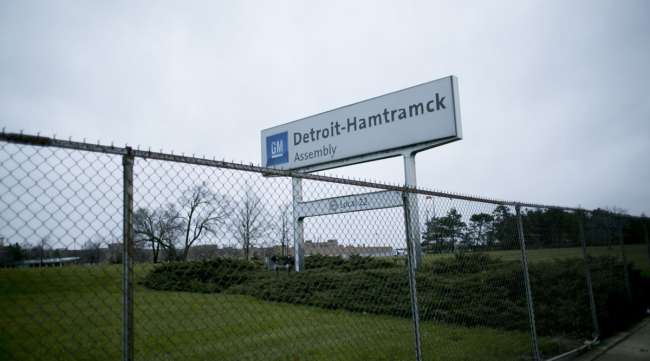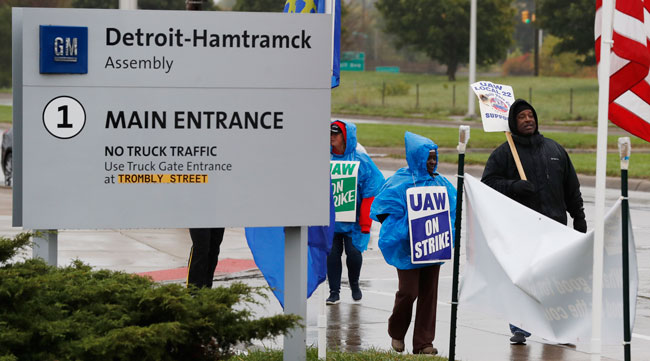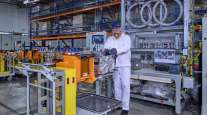The Detroit News
GM’s Detroit-Hamtramck Assembly Poised to Begin Electric Transformation

[Stay on top of transportation news: Get TTNews in your inbox.]
DETROIT — The last Chevrolet Impala will roll down the line next week at Detroit-Hamtramck Assembly, making way for the plant’s next phase: electric vehicles.
No longer will engines and transmissions be installed at the General Motors Co. factory. Electric motors and battery packs will take their place. By late 2021, GMC Hummer EVs will be built, followed by the Cruise Origin, a self-driving electric ride-sharing shuttle.
The facility targeted for closure until contract talks last fall with the United Auto Workers union will now become the automaker’s first all-electric vehicle assembly plant, central to GM’s aggressive EV plans.
Work on the $2.2 billion investment at the plant will start in March. The reworking of the plant will include comprehensive upgrades to the general assembly area and the paint and body shops, GM has said. Upgrades include new machines, conveyors, controls and tooling.
In part two of a two-part exploration of autonomous technology today, our latest RoadSigns podcast revisits conversations with Chuck Price of TuSimple and Ognen Stojanovski of Pronto.ai. Hear them discuss a palatable Level 2 version of trucking autonomy. Listen to a snippet above, and to hear the full episode, go to RoadSigns.TTNews.com.
“The plant configuration is probably going to change more dramatically than for a normal model changeover … in this case we will probably see the assembly line get gutted,” said Sam Abuelsamid, principal analyst at Navigant Research.
The changeover could include the inclusion of a battery-pack assembly line, Abuelsamid said, because of the volume of vehicles GM plans to build there.
Battery packs for the Chevrolet Bolt EV are assembled at LG Chem facilities in Hazel Park and South Korea. The automaker hasn’t said where battery packs for the new Detroit-Hamtramck products will come from. But the cells for those packs will come from GM’s new battery-cell manufacturing plant in Lordstown, Ohio, that it’s building in partnership with LG Chem. That plant will come online in 2022.
GM isn’t providing details on its Detroit-Hamtramck site layout to show if additions to the plant will be built. No site plan approvals have been submitted to officials in Detroit or Hamtramck; the plant straddles both cities.
Worker Concern
The coming conversion is a welcome change of course for the 900 workers there, but it does come with some concern about what will happen to them during the 12- to 18-month retooling.
“Everyone is excited for when the plant opens back up. Everyone is just nervous about what’s going to happen next,” said Chris Lage, a team leader at Detroit-Hamtramck. “Hopefully, everything works out in everyone’s favor.”
Lage, a nine-year employee, has been stressed about his future with GM since November 2018 when the automaker put the plant on a closure list. He had just purchased a new home that July.
Lage, 32, isn’t willing to sell his house and move out of the area, or drive more than an hour to plants in Flint or Lansing. So he’s hoping he can get a job at an area plant like Romulus Powertrain.
GM will offer jobs to displaced Detroit-Hamtramck workers at plants mostly in Michigan and Ohio. Those who go to locations an extended distance from their home plant — generally more than 60 miles — can opt for transfer-allowance packages of up to $30,000 and will not have recall rights back to Detroit-Hamtramck; or they can select a transfer allowance of $5,000 that has recall rights.
If workers are hired at area plants, no relocation allowance is offered. Employees are able to put in requests for where they would like to go and those are considered, but a main factor in where they end up is where GM needs them. Employees who decline offers to other plants will be laid off, but will still have recall rights back to their home plant.
GM will start sending offer letters by the end of the month.
Lage is concerned he won’t be able to get a position at a nearby plant because he has been told the union will not displace temporary employees to place employees with seniority. Positions are filled according to the international and local plant agreements, the UAW said.
“This is where it gets really disheartening,” Lage said. “I can’t say how I am going to feel in two weeks, but I am pretty much going to lose my job for a year and a half.”
Lage says he’d decline a transfer to a distant plant, but still wants to be a part of the future at Detroit-Hamtramck.
“There’s going to be a lot of opportunities there,” he said. “Of course I want to come back and thrive and try to better myself.”

GM President Mark Reuss speaks during an announcement of the company's $2.2 billion investment in the Detroit-Hamtramck Assembly electric conversion on Jan. 27. (Ryan Garza/Detroit Free Press)
‘Home and the Future’
The 4.1 million-square-foot Detroit-Hamtramck facility first opened in 1985. It has built more than 4 million vehicles including the Pontiac Bonneville, Chevrolet Volt, Buick LeSabre, Oldsmobile Toronado and Trofeo, and the Cadillac Eldorado, Seville and DeVille.
Detroit-Hamtramck has the capacity to build 160,000 vehicles a year, but in 2019 only utilized about 22% of that, according to data from LMC Automotive, an auto industry forecast company.
LMC expects fewer than 50,000 vehicles to be produced annually there through 2023, unless the Origin has a much higher fleet volume than expected.
GM said it expects to employ 2,200 when the plant reaches full capacity.
David Parnell Jr., 46, hopes to be one of those employees. He worked at Detroit-Hamtramck previously and took a transfer to Flint Assembly when GM originally put his plant on the chopping block.
“It’s home and the future,” Parnell said. “I would like to finish out my career basically being a part of something that is going to be really special at D-Ham.”
The plant’s survival came at the conclusion of the fall 2019 negotiations between the UAW and GM that only ended after a 40-day national strike by nearly 50,000 GM employees.
“During the 40-day strike with General Motors, UAW members were able to secure a contract that keeps Hamtramck open and will transform the plant into a leader in electric vehicles of the future,” Terry Dittes, UAW vice president and director of the GM department, said in a statement to The Detroit News. “Our members also secured through collective bargaining protections during the plant renovations that secure their jobs within GM until the plant reopens.”

UAW members walk the picket line outside the Detroit-Hamtramck Assembly on Oct. 16, 2019. (Carlos Osorio/Associated Press)
‘Sweetly Symbolic’
Hamtramck city leaders are excited at the potential for the future. It’s a stark contrast from how they felt two years ago when the plant was on the closure list. The potential dismantling of the factory stung especially bad because in the 1980s an entire Hamtramck neighborhood was demolished to make way.
“Of course it sent shock waves through the entire city,” Hamtramck Mayor Karen Majewski said.
While she sees the union’s fight as a major reason for Detroit-Hamtramck’s survival, Majewski also hopes the discussions community leaders had with the automaker kept the plant alive.
“I realize these decisions are made based on numbers, but I like to think that part of it is a respect for what Detroit means for the auto industry,” she said.
Hamtramck, which was born out of the auto industry through the presence of the Dodge Main plant there, will celebrate its 100th year anniversary as a city in 2022.
“This development is coinciding with that anniversary, so for us it’s sweetly symbolic,” Majewski said. “As we step out into a new era, this plant is, too.”
Want more news? Listen to today's daily briefing:
Distributed by Tribune Content Agency, LLC





